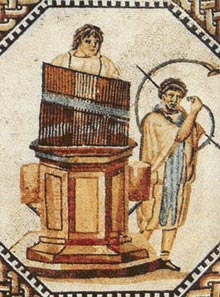
A cornu or cornum (Latin: cornū, cornūs or cornum, "horn", sometimes translated misleadingly as "cornet"; pl.: cornua) was an ancient Roman brass instrument about 3 m (9.8 ft) long in the shape of a letter 'G'. The instrument was braced by a crossbar that stiffened the structure and provided a means of supporting its weight on the player's shoulder. Some specimens survive in the archaeological record, two from the ruins of Pompeii.


The cornu may be difficult to distinguish from the buccina. It was used by the Roman army for communicating orders to troops in battle. In Roman art, the cornu appears among the instruments that accompany games (ludi) or gladiator combat in the arena, as on the Zliten mosaic.[1]
- ^ Wiedemann 1992, p. 15.